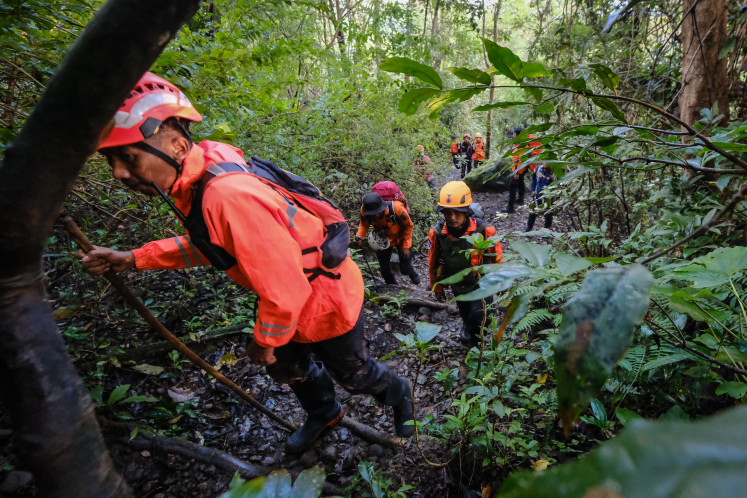Popular Reads
Top Results
Can't find what you're looking for?
View all search resultsPopular Reads
Top Results
Can't find what you're looking for?
View all search resultsHuman contact may have caused deaths of orangutans
Helpless: A female orangutan looks dejected as her offspring lies dead at Bukit Lawang in Mount Leuser National Park, Langkat regency, North Sumatra
Change text size
Gift Premium Articles
to Anyone
H
elpless: A female orangutan looks dejected as her offspring lies dead at Bukit Lawang in Mount Leuser National Park, Langkat regency, North Sumatra. Two young orangutans were reported to have died from unknown diseases in the past two weeks. (Courtesy of TNGL)
Two young male orangutans have been found dead in the past week in Bukit Lawang tourism area, Mount Leuser National Park, Langkat regency, North Sumatra. The orangutans are believed to have died of a disease transmitted from tourists who visited the area.
Joko Iswanto, the acting head of the national park, said the already decaying carcasses were found in the arms of their mothers. He said the mothers had carried the bodies with them everywhere while roaming the national park for days after their deaths.
Joko said the national park staff found the first body, a 3-year-old, on June 30. The second, a 1-year-old, was found on July 10.
“It was difficult to recover the two orangutans because we had to take the bodies away from the mothers,” Joko told The Jakarta Post in his office on Wednesday.
Yenny Saraswati, the veterinarian supervising the investigation into the deaths, said the condition of the bodies had hampered the necropsies necessary to determine the exact cause of death.
However, Yenny said both orangutans had empty stomachs when they died, which led to speculation that they were ill and had lost their appetites.
Yenny said the illness might have been a result of the orangutans’ contact with human visitors.
“Orangutans can easily contract diseases following frequent contact with humans,” Yenny said.
She added that this was a serious situation for orangutans in Bukit Lawang, which is a major attraction for foreign tourists visiting the national park.
Albert Turnip, the managing head of the Bahorok area of the national park, said Bukit Lawang had served as a rehabilitation center for orangutans since 1970. However, the area has been open to tourists as a viewing spot since 2012.
“Since being opened as an observation post, this location is always packed with tourists especially from abroad,” Albert said.
However, he said the national park management had yet to come to a definite conclusion on the cause of the young orangutans’ deaths.
“We’ll see in the next few days, if there are more deaths of young orangutans, we will conduct a health assessment,” he said.
The deaths of the two orangutans has added to the long list of endangered-animal deaths within the national park.
Panut Hadisiswoyo, the director of the Orangutan Information Center, said 49 orangutan deaths had been recorded between 1979 and 1999 in Bukit Lawang. Fifty-six percent of the deaths were caused by dysentery. During the period, Bukit Lawang was believed to have been home to 226 individual orangutans, including the 49 that died.
“Orangutans contract dysentery from contact with humans,” Panut told the Post.
Panut said a rehabilitation center should not also function as a tourist attraction because it puts the rehabilitated animals in danger.
However, there are no rules about separating rehabilitation centers from tourist areas, he said.
Panut further said the International Union for the Conservation of Nature and Natural Resources had stipulated that rehabilitation centers may function as tourist destinations as long as visitors are prohibited from having direct contact with animals or feeding them. Visitors also have to wear surgical masks and stay at least 10 meters away from the animals.
These stipulations, Panut said, had not been properly followed in Bukit Lawang, which has long been an icon of orangutan rehabilitation in Indonesia.
“If this is not taken care of, many orangutans may die as a result of unregulated contact with humans,” he said.
Bukit Lawang is home to numerous bird, plant and mammal species, most famously the Sumatran orangutan. According to the Mount Leuser National Park management, there are 5,700 orangutans in the park’s eastern block, 300 of which live in Bukit Lawang. The additions to the orangutan population in Bukit Lawang include rehabilitated adult orangutans and newborns.
The eastern block of the park boasts an area of 30,000 hectares encompassing Langkat and Aceh Tamiang, Aceh.










